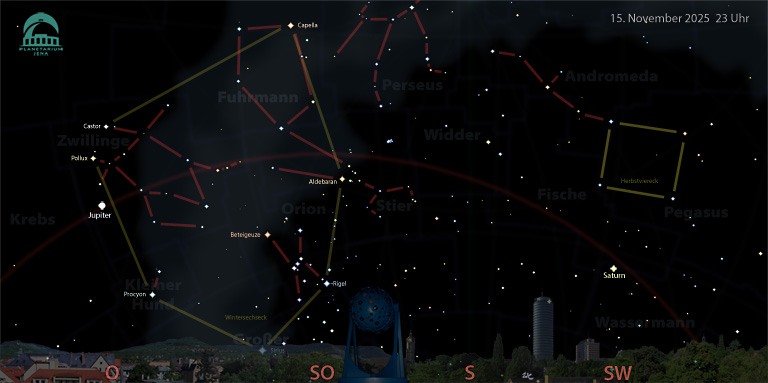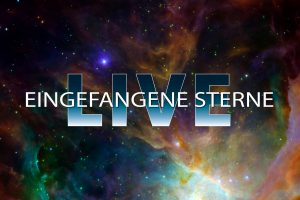Saturn und Jupiter am Abend, Venus am Morgen und Sternschnuppen Leoniden und Merkur in der zweiten Monatshälfte
Auch in diesem Monat verringern sich Mittagshöhe der Sonne und die Länge des hellen Tages weiter. Am 23. erreicht die Sonne das Tierkreissternbild Skorpion, das sie am 30. bereits wieder in Richtung Schlangenträger verlässt. Zuvor hielt sie sich vor der Waage auf.
Vollmond ist am 5. November, Neumond am 20.
Am frühen Abend folgt in südlicher Richtung der Ringplanet Saturn vor dem Tierkreissternbild Wassermann. Er wird ab 29. wieder rechtläufig, bewegt sich dann also wieder von West nach Ost. Etwas später erscheint nordöstlich der Riesenplanet Jupiter vor dem Tierkreissternbild Zwillinge. Jupiter kommt am 11. in Opposition zur Sonne und ist dann die ganze Nacht sichtbar.
Zur Monatsmitte deutet sich der nächste jahreszeitliche Wandel an. Im Südwesten funkeln die Sterne des Herbstvierecks. Die beiden Westlichen und der Untere östlich zählen zum Sternbild Pegasus, dem geflügelten Pferd aus der griechischen Mythologie. Mit dem oberen östlichen Stern beginnend zieht sich die Sternkette der Andromeda in den Südosten. Und wenn es sehr klar sein sollte, können sie hier auch den matten Nebelfleck von M31, der Andromedagalaxie sehen.
Aber im Osten zeigen sich bereits viele wintertypische Sterne und Sternbilder. Schon sehr hoch am Nachthimmel funkelt Kapella im Fuhrmann. Unter ihr Aldebaran im Stier, der auch durch den kleinen Sternhaufen der Plejaden bekannt ist. Auch der markante Orion zeigt sich über dem Südost-Horizont. Es folgt der funkelnde Sirius im Großen Hund, der hellste Stern am irdischen Himmel, darüber Prokyon im Kleinen Hund und die Zwillinge Kastor und Pollux.
Die ersten Frühlingssternbilder sind am Morgenhimmel zu finden, der Löwe gefolgt von der Jungfrau.
Venus ist noch am frühen Morgenhimmel über dem südöstlichen Horizont zu sehen. Auch Merkur ist zum Monatsende dort zu sehen.
Vom 13. bis 30. können die Leoniden beobachtet werden. Das diesjährige Maximum des Sternschnuppenstroms der Leoniden wird am Morgen des 17. mit nur 10 bis 15 Meteoren pro Stunde erwartet.
W. Don Eck
Zeiss-Planetarium Jena
Saturn and Jupiter in the evening, Venus in the morning and shooting stars Leonids and Mercury in the second half of the month
The Sun’s midday altitude and the length of the bright day also continue to decrease this month. On the 23rd, the Sun reaches the zodiacal constellation of Scorpio, which it leaves again on the 30th in the direction of the Serpent Bearer. Prior to this, it was in front of Libra.
Full moon is on 5 November, new moon on 20.
In the early evening, the ringed planet Saturn follows in a southerly direction in front of the zodiacal constellation of Aquarius. It will become retrograde again from the 29th, moving from west to east again. A little later, the giant planet Jupiter appears to the north-east in front of the zodiacal constellation Gemini. Jupiter comes into opposition to the Sun on the 11th and is then visible all night.
The next seasonal change begins in the middle of the month. The stars of the autumn quadrilateral will be twinkling in the southwest. The two western stars and the lower one to the east belong to the constellation Pegasus, the winged horse from Greek mythology. Starting with the upper eastern star, the Andromeda star chain stretches to the south-east. And if it is very clear, you can also see the dim nebula of M31, the Andromeda galaxy, here.
But many typical winter stars and constellations can already be seen in the east. Very high in the night sky, Capella is already twinkling in Auriga. Below it is Aldebaran in Taurus, which is also known for the small Pleiades star cluster. The striking Orion can also be seen above the south-east horizon. It is followed by the sparkling Sirius in the Great Dog, the brightest star in the terrestrial sky, and above it Prokyon in the Little Dog and the twins Castor and Pollux.
The first spring constellations can be found in the morning sky, Leo followed by Virgo.
Venus can still be seen in the early morning sky above the south-eastern horizon. Mercury can also be seen there at the end of the month.
The Leonids can be observed from the 13th to the 30th. This year’s maximum of the Leonids shooting star stream is expected on the morning of the 17th with only 10 to 15 meteors per hour.



